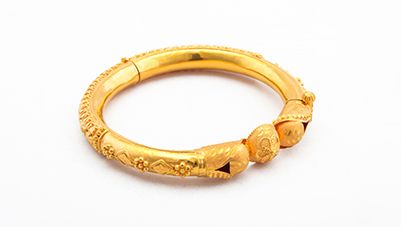Rs. 5,000 - Rs. 2 crore
To find the nearest gold loan branch,
Enter phone and OTP | Check amount you can get | Apply for quick funds
What is scrap gold?
Scrap gold simply refers to old, unused, or unwanted gold items that can be melted and reused. This includes broken jewellery, outdated pieces, dental gold, coins, or even tiny amounts of gold found in electronics. Even though the word "scrap" may sound like it has no value, the gold in these items is still valuable. When scrap gold is refined, it is melted down to extract pure gold that can be used again for jewellery, coins, or industrial work. Many people in India sell scrap gold to earn money from items they no longer use. Checking purity is important to know its true market value.
Common sources of scrap gold
Scrap gold comes from many everyday items. The most common source is broken or old jewellery like rings, necklaces, or earrings that people no longer wear. Dental gold from crowns and fillings also adds to the scrap supply. Damaged gold coins or bars that are no longer fit for trading often get recycled too. A big share of scrap gold also comes from electronics, where tiny gold parts are used in circuits and connectors. Antique pieces, watches, and decorative items may also contain gold that can be recovered. These different sources ensure a steady supply of gold for recycling and help people make use of gold they no longer need.
What are common types of scrap gold?
| Type | Description |
| Jewellery | Broken, outdated, or damaged jewellery like earrings, chains, or rings |
| Dental gold | Gold from fillings, crowns, or bridges |
| Coins and bars | Damaged or old coins and bullion bars |
| Industrial gold | Gold used in electronics, circuit boards, and connectors |
| Antique items | Gold recovered from decorative pieces, vintage watches, or artefacts |
| Gold dust and scraps | Residues from jewellery crafting or polishing processes |
How is scrap gold mined?
Scrap gold mining refers to the process of recovering and refining gold from unused or discarded items. The process begins by collecting scrap gold from jewellery, coins, electronics, or dental items. The collected gold is then melted at high temperatures to separate impurities and alloys, leaving behind pure gold. Advanced refining techniques, such as electrolysis or chemical treatment, ensure precision and efficiency in extracting gold. After refining, the pure gold is repurposed into new jewellery, bullion, or industrial components. This eco-friendly method reduces the need for traditional gold mining, preserving natural resources and minimising environmental impact. In India, scrap gold mining is gaining popularity as a sustainable way to meet the growing demand for gold.
What makes scrap gold the best gold investment?
Scrap gold is an excellent investment due to its affordability, accessibility, and sustainability. Purchasing scrap gold often comes at a lower premium than newly minted gold, offering cost-effective opportunities for buyers. It retains its value, as its worth is determined by its gold content, making it a secure investment option. Scrap gold is also eco-friendly, reducing reliance on traditional mining processes that harm the environment. Investors can sell scrap gold easily in the market, ensuring liquidity when needed. Additionally, scrap gold offers flexibility, as it can be recycled into new forms of jewellery, coins, or industrial uses. For Indian buyers, scrap gold provides a reliable avenue for wealth preservation, with the potential for significant returns during market fluctuations. Its versatility and enduring value make it a smart choice for gold investors.
Quick tip: Have idle gold lying at home? Turn it into instant funds with a Bajaj Finserv Gold Loan today! Apply now
How is scrap gold valued?
Scrap gold is valued based on its purity, weight, and prevailing market rates. The first step is testing the gold for purity, typically measured in karats, with 24 karat representing pure gold. Higher purity levels result in higher valuation. The weight of the gold, measured in grams or ounces, is then multiplied by the current market price per gram or ounce to calculate its value. Other factors, such as making charges for jewellery and associated costs, may affect the final price. For accurate valuation, it is recommended to use certified testing methods like XRF analysis or hallmarking verification. Knowing the value of scrap gold helps individuals maximise its resale potential or use it effectively for financial products like gold loans.
How to sell your scrap gold?
Selling scrap gold involves a few essential steps to ensure you receive the best value. Start by assessing the purity of your gold through hallmarking or certified testing methods. Weigh the gold accurately to determine its total weight. Research current gold market rates to understand its approximate value. Approach reputable jewellers, refiners, or financial institutions for a transparent transaction. Compare offers from multiple buyers to secure the best price. Retain invoices and documentation for authenticity. If selling gold jewellery, ensure that making charges and impurities are not deducted unfairly. These steps ensure a smooth and profitable process for selling your scrap gold.
Impact of scrap gold on gold loan
Scrap gold significantly impacts gold loans, as it provides a readily available resource for collateral. Gold loan eligibility depends on the purity and weight of the pledged gold. Scrap gold, once tested for purity and recycled into jewellery, can be valued and used for obtaining loans.
Bajaj Finance accepts 18-22 karat hallmarked and certified gold jewellery for valuation, ensuring borrowers receive competitive loan amounts. The recycling nature of scrap gold makes it a sustainable and practical option for leveraging financial needs. Its ease of valuation and enduring value make it a reliable asset for securing funds through gold loans. Understanding the potential of gold helps borrowers optimise their loan terms and meet eligibility criteria effectively.
If you want to make the most of your hallmarked gold, check your gold loan eligibility today and unlock quick funds against your verified jewellery—all while ensuring complete safety and transparency.
Related Articles
Disclaimer
Bajaj Finance Limited has the sole and absolute discretion, without assigning any reason to accept or reject any application. Terms and conditions apply*.
For customer support, call Personal Loan IVR: 7757 000 000









 Personal Loan
Personal Loan Check Eligibility
Check Eligibility Salaried Personal Loan
Salaried Personal Loan EMI Calculator
EMI Calculator Account Aggregator
Account Aggregator Credit Pulse Report
Credit Pulse Report
 Deals starting @99
Deals starting @99 Min. 50% off
Min. 50% off
 Bajaj Pay
Bajaj Pay Wallet to Bank
Wallet to Bank
 Easy EMI Loan
Easy EMI Loan Savings Offer
Savings Offer Smartphones
Smartphones Led TVs
Led TVs Washing Machines
Washing Machines Laptops
Laptops Refrigerators
Refrigerators Air Conditioner
Air Conditioner Air Coolers
Air Coolers
 Loan Against Shares
Loan Against Shares Loan Against Mutual Funds
Loan Against Mutual Funds Loan Against Insurance Policy
Loan Against Insurance Policy ESOP Financing
ESOP Financing Easy EMI Loan
Easy EMI Loan Two-wheeler Loan
Two-wheeler Loan Loan for Lawyer
Loan for Lawyer Industrial Equipment Finance
Industrial Equipment Finance Industrial Equipment Balance Transfer
Industrial Equipment Balance Transfer Industrial Equipment Refinance
Industrial Equipment Refinance Personal Loan Branch Locator
Personal Loan Branch Locator Used Tractor Loan
Used Tractor Loan Loan Against Tractor
Loan Against Tractor Tractor Loan Balance Transfer
Tractor Loan Balance Transfer Flexi
Flexi View All
View All
 Two-wheeler Loan
Two-wheeler Loan Bike
Bike Scooter
Scooter Electric Vehicle
Electric Vehicle Best Sellers
Best Sellers Popular Brands
Popular Brands

 Trading Account
Trading Account Open Demat Account
Open Demat Account Margin Trading Financing
Margin Trading Financing Share Market
Share Market Invest in IPO
Invest in IPO All stocks
All stocks Top gainers
Top gainers Top losers
Top losers 52 week high
52 week high 52 week low
52 week low Loan against shares
Loan against shares
 Home Loan
Home Loan Transfer your existing Home loan
Transfer your existing Home loan Loan against Property
Loan against Property Home Loan for Salaried
Home Loan for Salaried Home loan for self employed
Home loan for self employed Loan Against Property Balance Transfer
Loan Against Property Balance Transfer Home Loan EMI Calculator
Home Loan EMI Calculator Home Loan eligibility calculator
Home Loan eligibility calculator Home Loan balance transfer
Home Loan balance transfer View All
View All
 Term Life Insurance
Term Life Insurance ULIP Plan
ULIP Plan Savings Plan
Savings Plan Family Insurance
Family Insurance Senior Citizen Health Insurance
Senior Citizen Health Insurance Critical Illness Insurance
Critical Illness Insurance Child Health Insurance
Child Health Insurance Pregnancy and Maternity Health Insurance
Pregnancy and Maternity Health Insurance Individual Health Insurance
Individual Health Insurance Low Income Health Insurance
Low Income Health Insurance Student Health Insurance
Student Health Insurance Group Health Insurance
Group Health Insurance Retirement Plans
Retirement Plans Child Plans
Child Plans Investment Plans
Investment Plans
 Business Loan
Business Loan Secured Business Loan
Secured Business Loan Loan against property
Loan against property Loans against property balance transfer
Loans against property balance transfer Loan against shares
Loan against shares Home Loan
Home Loan Loans against mutual funds
Loans against mutual funds Loan against bonds
Loan against bonds Loan against insurance policy
Loan against insurance policy
 Apply for Gold Loan
Apply for Gold Loan Transfer your Gold Loan with Us
Transfer your Gold Loan with Us Gold Loan Branch Locator
Gold Loan Branch Locator
 ULIP Plan
ULIP Plan Savings Plan
Savings Plan Retirement Plans
Retirement Plans Child Plans
Child Plans Free Demat Account
Free Demat Account Invest in Stocks
Invest in Stocks Invest in IPO
Invest in IPO Margin Trading Facility
Margin Trading Facility Fixed Deposit Branch Locator
Fixed Deposit Branch Locator
 Check your Credit Score
Check your Credit Score
 New Car Loan
New Car Loan Used Car Loan
Used Car Loan Loan Against Car
Loan Against Car Car Loan Balance Transfer and Top-up
Car Loan Balance Transfer and Top-up My Garage
My Garage
 Get Bajaj Prime
Get Bajaj Prime
 Mobiles on EMI
Mobiles on EMI Electronics on EMI Offer
Electronics on EMI Offer  Iphone on EMI
Iphone on EMI LED TV on EMI
LED TV on EMI Refrigerator on EMI
Refrigerator on EMI Laptop on EMI
Laptop on EMI Kitchen appliances on EMI
Kitchen appliances on EMI Washing machines
Washing machines
 Personal Loan EMI Calculator
Personal Loan EMI Calculator Personal Loan Eligibility Calculator
Personal Loan Eligibility Calculator Home Loan EMI Calculator
Home Loan EMI Calculator Home Loan Eligibility Calculator
Home Loan Eligibility Calculator Good & Service Tax (GST) Calculator
Good & Service Tax (GST) Calculator Flexi Day Wise Interest Calculator
Flexi Day Wise Interest Calculator Flexi Transaction Calculator
Flexi Transaction Calculator Secured Business Loan Eligibility Calculator
Secured Business Loan Eligibility Calculator Fixed Deposits Interest Calculator
Fixed Deposits Interest Calculator Two wheeler Loan EMI Calculator
Two wheeler Loan EMI Calculator New Car Loan EMI Calculator
New Car Loan EMI Calculator Used Car Loan EMI Calculator
Used Car Loan EMI Calculator All Calculator
All Calculator Used Tractor Loan EMI Calculator
Used Tractor Loan EMI Calculator
 Hot Deals
Hot Deals Clearance Sale
Clearance Sale Kitchen Appliances
Kitchen Appliances Tyres
Tyres Camera & Accessories
Camera & Accessories Mattresses
Mattresses Furniture
Furniture Watches
Watches Music & Audio
Music & Audio Cycles
Cycles Mixer & Grinder
Mixer & Grinder Luggage & Travel
Luggage & Travel Fitness Equipment
Fitness Equipment Fans
Fans
 Personal Loan for Doctors
Personal Loan for Doctors Business loan for Doctors
Business loan for Doctors Home Loan
Home Loan Secured Business Loan
Secured Business Loan Loan against property
Loan against property Secured Business Loan Balance Transfer
Secured Business Loan Balance Transfer Loan against share
Loan against share Gold Loan
Gold Loan Medical Equipment Finance
Medical Equipment Finance
 Smart Hub
Smart Hub ITR Service
ITR Service Digi Sarkar
Digi Sarkar
 Savings Offer
Savings Offer Easy EMI
Easy EMI Offer World
Offer World 1 EMI OFF
1 EMI OFF New Launches
New Launches Zero Down Payment
Zero Down Payment Clearance Sale
Clearance Sale Bajaj Mall Sale
Bajaj Mall Sale
 Mobiles under ₹20,000
Mobiles under ₹20,000 Mobiles under ₹25,000
Mobiles under ₹25,000 Mobiles under ₹30,000
Mobiles under ₹30,000 Mobiles under ₹35,000
Mobiles under ₹35,000 Mobiles under ₹40,000
Mobiles under ₹40,000 Mobiles under ₹50,000
Mobiles under ₹50,000
 Articles
Articles
 Overdue Payments
Overdue Payments Other Payments
Other Payments
 Document Center
Document Center Bank details & Documents
Bank details & Documents Tax Invoice Certificate
Tax Invoice Certificate
 Do Not Call Service
Do Not Call Service
 Hamara Mall Orders
Hamara Mall Orders

 Fixed Deposit (IFA) Partner
Fixed Deposit (IFA) Partner Loan (DSA) Partner
Loan (DSA) Partner Debt Management Partner
Debt Management Partner EMI Network Partner
EMI Network Partner Became a Merchant
Became a Merchant Partner Sign-in
Partner Sign-in
 Trade directly with your Demat A/c
Trade directly with your Demat A/c ITR
ITR My Garage
My Garage
 Live Videos - Beta
Live Videos - Beta
 Savings Offer
Savings Offer Smartphones
Smartphones LED TVs
LED TVs Washing Machines
Washing Machines Laptops
Laptops Refrigerators
Refrigerators Air Conditioners
Air Conditioners Air Coolers
Air Coolers Water Purifiers
Water Purifiers Tablets
Tablets Kitchen Appliances
Kitchen Appliances Mattresses
Mattresses Furniture
Furniture Music and Audio
Music and Audio Cameras & Accessories
Cameras & Accessories Cycle
Cycle Watches
Watches Tyres
Tyres Luggage & Travel
Luggage & Travel Fitness Equipment
Fitness Equipment Tractor
Tractor Easy EMI Loan
Easy EMI Loan
 vivo Mobiles
vivo Mobiles OPPO Mobiles
OPPO Mobiles Xiaomi Mobiles
Xiaomi Mobiles Sony LED TVs
Sony LED TVs Samsung LED TVs
Samsung LED TVs LG LED TVs
LG LED TVs Haier LED TVs
Haier LED TVs Godrej Refrigerators
Godrej Refrigerators Voltas Washing Machines
Voltas Washing Machines
 New Tractor Loan
New Tractor Loan Used Tractor Loan
Used Tractor Loan Loan Against Tractor
Loan Against Tractor Tractor Loan Balance Transfer
Tractor Loan Balance Transfer
 New Car Loan
New Car Loan New Cars Under ₹10 Lakh
New Cars Under ₹10 Lakh New Cars – ₹10–₹15 Lakh
New Cars – ₹10–₹15 Lakh New Cars – ₹15–₹20 Lakh
New Cars – ₹15–₹20 Lakh New Cars – ₹20–₹25 Lakh
New Cars – ₹20–₹25 Lakh New Car Brands
New Car Brands Petrol – New Cars
Petrol – New Cars Diesel – New Cars
Diesel – New Cars Electric – New Cars
Electric – New Cars CNG – New Cars
CNG – New Cars Hybrid – New Cars
Hybrid – New Cars









